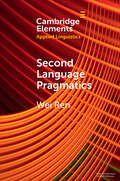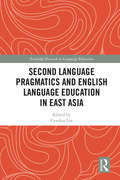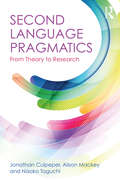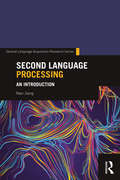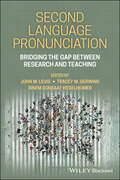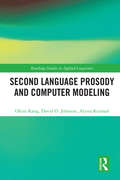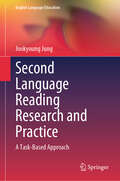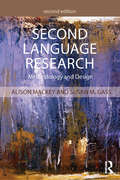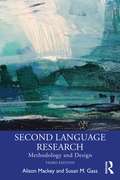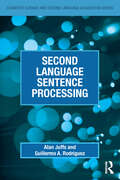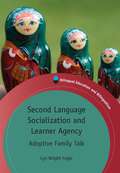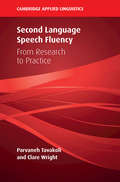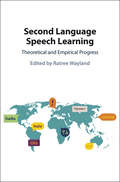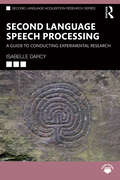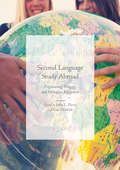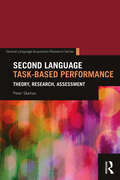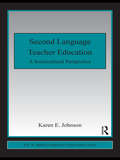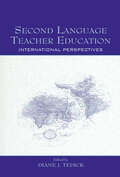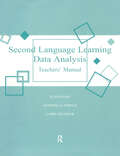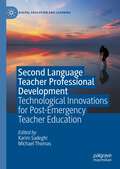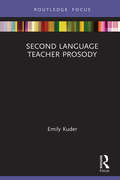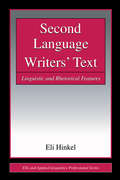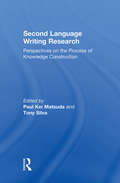- Table View
- List View
Second Language Pragmatics (Elements in Applied Linguistics)
by Wei RenThis Element introduces the areas that second language (L2) pragmatics research has investigated. It begins with a theme-based review of the field with respect to L2 pragmatics learning, teaching, and assessing. The section on pragmatics learning examines studies on learners' pragmatic production and perception, and analyzes research modalities in this field. The section on pragmatics teaching examines the effects of and different approaches to L2 pragmatics instruction; and the section on pragmatics assessing examines the aspects involved in testing learners' pragmatic competence, and studies on issues related to validity and rating in pragmatics assessing. The Element then analyzes studies exploring learners' cognitive processes during pragmatic performance, and case studies are provided to showcase two ongoing projects, one investigating advanced learners' self-praise on social media and the other investigating lingua franca pragmatics among children. Finally, the Element offers some topics and questions for future research in L2 pragmatics.
Second Language Pragmatics and English Language Education in East Asia (Routledge Research in Language Education)
by Cynthia LeeThis edited collection addresses the link between second language pragmatics (including interlanguage and intercultural) research and English language education. The chapters use different contemporary research methods and theoretical frameworks such as conversation analysis, language-learners-as-ethnographers, discourse and interactional approaches and data in contexts (either in the region or overseas). The content explores and discusses the significance of learning and teaching of second language (L2) pragmatics in language education for learners who use English as a lingua franca for academic and intercultural communication purposes with native and non-native speakers of English, focusing on pragmatic actions, social behaviours, perceptions and awareness levels in three regions in East Asia – China, Japan and South Korea. It is an important contribution to the area of second language pragmatics in language education for East Asian learners. It recommends research-informed pedagogies for the learning and teaching of interlanguage or intercultural pragmatics in regions and places where similar cultural beliefs or practices are found. This is an essential read for researchers, language educators, classroom teachers, readers who are interested in second language pragmatics research and those interested in second language acquisition and English language education in the East Asian context.
Second Language Pragmatics: From Theory to Research
by Jonathan Culpeper Alison Mackey Naoko TaguchiSecond Language Pragmatics: From Theory to Research aims to reinvigorate this field, pointing the way forward to new methodologies that can drive, or be driven by, new theoretical developments. With a unique combination of leading international expertise in general pragmatics, L2 pragmatics, and research methodology, the authors describe in detail the methods, including the most recent techniques, by which pragmatics of all types can be pursued in L2 contexts. This volume argues that L2 pragmatics research needs to expand from its initial base by drawing from a wider range of sources, such as Corpus Linguistics and Psycholinguistics. Clear, accessible, and practical, Second Language Pragmatics will be valuable to novice and seasoned researchers alike in second language pragmatics, general pragmatics, and second language acquisition courses.
Second Language Processing: An Introduction (Second Language Acquisition Research Series)
by Nan JiangSecond Language Processing: An Introduction is the first textbook to offer a thorough introduction to the field of second language processing (SLP). The study of SLP seeks to illuminate the cognitive processes underlying the processing of a non-native language. While current literature tends to focus on one topic or area of research, this textbook aims to bring these different research strands together in a single volume, elucidating their particularities while also demonstrating the relationships between them. The book begins by outlining what is entailed in the study of SLP, how it relates to other fields of study, and some of the main issues shared across its subareas. It then moves into an exploration of the three major areas of current research in the field—phonological processing, lexical processing, and sentence processing. Each chapter provides a broad overview of the topic and covers the major research methods, models, and studies germane to that area of study. Ideal for students and researchers working in this growing field, Second Language Processing will serve as the go-to guide for a complete examination of the major topics of study in SLP.
Second Language Pronunciation: Bridging the Gap Between Research and Teaching
by John M. Levis Tracey M. Derwing Sinem Sonsaat-HegelheimerPractical resources designed to help language educators apply the latest research and most effective pedagogical methods to classroom pronunciation instruction In Second Language Pronunciation: Bridging the Gap Between Research and Teaching, a team of distinguished researchers and educators delivers an incisive and practical approach to evidence-based pronunciation instruction in second language classrooms. Developed for language teachers who want to incorporate and implement the most effective pedagogical methods in their language instruction, this edited volume offers 15 essays that connect the latest research with practical applications in the classroom. In addition to exploring recent but less well-known methods—like High Variability Phonetic Training, discourse-based teaching, communicative classrooms, and technology-based methods—these chapters are unified in bringing theory to bear on practical questions faced by language teachers. The chapters follow a standard format, moving from critical research issues to pedagogical implications, and practical resources to equip language teachers, scholars, administrators, and teachers-in-training with the tools they require to develop their students’ pronunciation abilities. Readers will also find: A thorough introduction to using empirical evidence to guide pronunciation instruction in second language students Comprehensive explorations of the integration of pronunciation instruction into second language education Practical discussions of perception training in pronunciation instruction and the importance of L2 segmental and suprasegmental contrasts in pronunciation learning In-depth examinations of classroom research for pronunciation and the use of technology to explore L2 pronunciationPerfect for upper-level undergraduate and graduate students studying TESOL, applied linguistics, and second language acquisition, Second Language Pronunciation: Bridging the Gap Between Research and Teaching will also earn a place in the libraries of researchers, scholars, and teachers of language and education.
Second Language Prosody and Computer Modeling (Routledge Studies in Applied Linguistics)
by Okim Kang David O. Johnson Alyssa KermadThis volume presents an interdisciplinary approach to the study of second language prosody and computer modeling. It addresses the importance of prosody’s role in communication, bridging the gap between applied linguistics and computer science. The book illustrates the growing importance of the relationship between automated speech recognition systems and language learning assessment in light of new technologies and showcases how the study of prosody in this context in particular can offer innovative insights into the computerized process of natural discourse. The book offers detailed accounts of different methods of analysis and computer models used and demonstrates how these models can be applied to L2 discourse analysis toward predicting real-world language use. Kang, Johnson, and Kermad also use these frameworks as a jumping-off point from which to propose new models of second language prosody and future directions for prosodic computer modeling more generally. Making the case for the use of naturalistic data for real-world applications in empirical research, this volume will foster interdisciplinary dialogues across students and researchers in applied linguistics, speech communication, speech science, and computer engineering.
Second Language Reading Research and Practice: A Task-Based Approach (English Language Education #43)
by Jookyoung JungThis book offers a concise and comprehensive review of theories and practical guidelines on how to adopt a task-based approach to second language (L2) reading instruction. The various chapters within and across the book bridge the boundaries between L2 reading research and classroom practices. Each chapter provides concrete teaching suggestions based on the theories and research findings on task-based L2 reading. This book offers step-by-step guidelines on how to implement task-based L2 reading instruction, such as needs analysis, task design, text development, task management, and task-based reading assessment. In so doing, this book helps readers increase their awareness of the symbiotic relationship between L2 reading research and instruction, which helps overcome the discrepancies between theoretical and pedagogical approaches. This book serves as a useful resource for researchers who aim to employ a task-based approach to L2 reading, undergraduate or postgraduate students who need to acquire basic knowledge on fundamental theories of L2 reading and the task-based approach, and in- or pre-service teachers who want to improve their teaching skills based on a robust understanding of relevant theories and research findings on task-based L2 reading.
Second Language Research: Methodology and Design
by Alison Mackey Susan M. GassIn this second edition of the best-selling Second Language Research, Alison Mackey and Sue Gass continue to guide students step-by-step through conducting the second language research process with a clear and comprehensive overview of the core issues in second language research. Supported by a wealth of data examples from actual studies, the book examines questions of what is meant by research and what defines good research questions, covering such topics as basic research principles and data collection methods, designing a quantitative research study, and concluding and reporting research findings. The second edition includes a new chapter on mixed-methods, new "time to think" and "time to do" text boxes throughout, and updates to reflect the latest research and literature. Supplementary materials, including an extensive glossary and appendices of forms and documents that students can use in conducting their own studies, serve as useful reference tools, with suggestions on how to get research published reemphasizing the book’s practical how-to approach. Second Language Research, Second Edition is the ideal resource for understanding the second language research process for graduate students in Second Language Acquisition and Applied Linguistics.
Second Language Research: Methodology and Design
by Alison Mackey Susan M. GassSecond Language Research: Methodology and Design is a clear, comprehensive overview of core issues in L2 research. Authored by well-known scholars in SLA and supported by a wealth of examples from actual studies and extensive pedagogical resources, this book first introduces students to the key topics and debates in L2 research. It then guides readers step by step through the research process—from basic principles and collection methods through study design and reporting—to the point of being able to conduct their own research from beginning to end. This book is an essential text for students and novice researchers of SLA, applied linguistics, and second and foreign language teaching. Key Features A wealth of graphics, visuals, and exercises in each chapter. "Time to Think" and "Time to Do" boxes within chapters Helpful glossary and subject index New to This Edition Substantially reorganized chapters Significantly expanded chapters on qualitative and mixed methods Substantive revised material on computer/technology-based research Spotlights a variety of new software packages and databases, including video-mediated technology and games Discusses the Open Science Movement Expanded coverage of corpora, processing, and psycholinguistics-based research Updated references throughout
Second Language Sentence Processing (Cognitive Science and Second Language Acquisition Series)
by Alan Juffs Guillermo A. RodríguezThis addition to the Cognitive Science and Second Language Acquisition series presents a comprehensive review of the latest research findings on sentence processing in second language acquisition. The book begins with a broad overview of the core issues of second language sentence processing research and then narrows its focus by dedicating individual chapters to each of these key areas. While a number of publications have discussed research findings on knowledge of formal syntactic principles as part of theories of second language acquisition, there are fewer resources dedicated to the role of second language sentence processing in this context. This volume will act as the first full-length literature review of the field on the market.
Second Language Socialization and Learner Agency
by Lyn Wright FogleThis book examines how Russian-speaking adoptees in three US families actively shape opportunities for language learning and identity construction in everyday interactions. By focusing on a different practice in each family (i.e. narrative talk about the day, metalinguistic discourse or languaging, and code-switching), the analyses uncover different types of learner agency and show how language socialization is collaborative and co-constructed. The learners in this study achieve agency through resistance, participation, and negotiation, and the findings demonstrate the complex ways in which novices transform communities in transnational contexts. The perspectives inform the fields of second language acquisition and language maintenance and shift. The book further provides a rare glimpse of the quotidian negotiations of adoptive family life and suggestions for supporting adoptees as young bilinguals.
Second Language Speech
by Colantoni, Laura and Steele, Jeffrey and Escudero, Paola Laura Colantoni Jeffrey Steele Paola EscuderoSecond language acquisition has rapidly grown as a field over the past decade, as our knowledge of the ways in which children and adults learn and use a second language has become crucial for effective language teaching. In addition to this important 'applied' function, research into second language acquisition has also informed the fields of linguistics and psychology in general, as it has shed light on the differences between native and non-native models of human language and cognition. The focus of this accessible new book is second language speech - that is, how speakers perceive, process, understand and pronounce the sounds of a second language. Each chapter includes review questions, and most chapters include 'tutorial' and 'lab' sections with practical exercises based on the University of Toronto Romance Phonetics Database (available online for free). The book also has a companion website, containing illustrated answers to the exercises, scripts for running acoustic analyses and useful weblinks.
Second Language Speech Fluency: From Research to Practice (Cambridge Applied Linguistics)
by Parvaneh Tavakoli Clare WrightSecond language (L2) fluency is an exciting and fast-moving field of research, with clear practical applications in language teaching. This book provides a lively overview of the current advances in the field of L2 fluency, and connects the theory to practice, presenting a hands-on approach to using fluency research across a range of different language-related professions. The authors introduce an innovative multidisciplinary perspective, which brings together research into cognitive and social factors, to understand fluency as a dynamic variable in language performance, connecting learner-internal factors such as speech processing and automaticity, to external factors such as task demands, language testing, and pragmatic interactional demands in communication. Bringing a much-needed multidisciplinary and novel approach to understanding the complex nature of L2 speech fluency, this book provides researchers, students and language professionals with both the theoretical insights and practical tools required to understand and research how fluency in a second language develops.
Second Language Speech Learning: Theoretical and Empirical Progress
by Ratree WaylandIncluding contributions from a team of world-renowned international scholars, this volume is a state-of-the-art survey of second language speech research, showcasing new empirical studies alongside critical reviews of existing influential speech learning models. It presents a revised version of Flege's Speech Learning Model (SLM-r) for the first time, an update on a cornerstone of second language research. Chapters are grouped into five thematic areas: theoretical progress, segmental acquisition, acquiring suprasegmental features, accentedness and acoustic features, and cognitive and psychological variables. Every chapter provides new empirical evidence, offering new insights as well as challenges on aspects of the second language speech acquisition process. Comprehensive in its coverage, this book summarises the state of current research in second language phonology, and aims to shape and inspire future research in the field. It is an essential resource for academic researchers and students of second language acquisition, applied linguistics and phonetics and phonology.
Second Language Speech Processing: A Guide to Conducting Experimental Research (ISSN)
by Isabelle DarcyThis book is the first hands-on roadmap for conducting rigorous experimental research on second language speech processing and spoken word recognition.Isabelle Darcy expertly defines key concepts and offers a detailed step-by-step guide to designing empirical psycholinguistic research in this complex, interdisciplinary area. The book covers the following: setting up an efficient workflow to enhance reproducibility of findings; determining a methodology; selecting experimental controls and designing stimuli; collecting data using an array of methodological tools; addressing common challenges; preparing and analyzing data; preregistering the study; and sharing data transparently in accordance with Open Science practices. Darcy provides everything needed to design and carry out robust behavioral studies on L2 speech processing, in a laboratory or online.This book will be an invaluable practical resource for researchers and advanced students in second language speech learning, second language acquisition, psycholinguistics, cognitive science, and language teaching, as well as those interested in applied linguistics, pronunciation, and related subjects.
Second Language Study Abroad: Programming, Pedagogy, And Participant Engagement
by John L. Plews Kim MisfeldtThis edited volume explores studying second languages abroad by critically and constructively reviewing established programming, providing theoretical and research-informed support for pedagogical and curriculum interventions, and analysing participant experiences. Over 12 chapters the contributors examine key issues including teaching approaches, learning activities, and relationships in the target language and culture. This book is most distinct in its attempt to promote diversity in approaches and experiences while drawing the common thread of learner- and learning-centredness through each chapter. The contributing authors represent a wide range of academies and discuss study abroad programs and participants in diverse cultural and geographic regions. The book’s international scope will acquaint educators and researchers with a broad variety of practices, stimulate comparison across contexts, and promote innovation.
Second Language Task-Based Performance: Theory, Research, Assessment (Second Language Acquisition Research Series)
by Peter SkehanSecond Language Task-Based Performance is the first book to synthesize Peter Skehan’s theoretical and empirical contributions all in one place. With three distinct themes explored in each section (theory, empirical studies, and assessment), Skehan’s influential body of work is organized in such a way that it provides an updated reflection on the material and makes it relevant to today’s researchers. Also in each section, an early publication is matched by at least one later publication, followed by a newly written commentary chapter, the combination of which provides the important function of offering a wider-ranging discussion. This book is an invaluable resource for researchers interested in second language task-based research or SLA more generally.
Second Language Teacher Education: A Sociocultural Perspective (ESL & Applied Linguistics Professional Series)
by Karen JohnsonThis book presents a comprehensive overview of the epistemological underpinnings of a sociocultural perspective on human learning and addresses in detail what this perspective has to offer the field of second language teacher education. Captured through five changing points of view, it argues that a sociocultural perspective on human learning changes the way we think about how teachers learn to teach, how teachers think about language, how teachers teach second languages, the broader social, cultural, and historical macro-structures that are ever present and ever changing in the second language teaching profession, and what constitutes second language teacher professional development. Overall, it clearly and accessibly makes the case that a sociocultural perspective on human learning reorients how the field understands and supports the professional development of second language teachers.
Second Language Teacher Education: International Perspectives
by Diane J. TedickThe education of second language teachers takes place across diverse contexts, levels, settings, and geographic regions. By bringing together research, theory, and best practices from a variety of contexts (ESL/EFL, foreign language, bilingual and immersion education), this book contributes to building meaningful professional dialogue among second-language teacher educators. Featuring an international roster of authors, the volume is comprised of 18 chapters organized in four thematic sections: the knowledge base of second language teacher education; second language teacher education contexts; collaborations in second language teacher education; and second language teacher education in practice. Second Language Teacher Education: International Perspectives is an essential professional resource for practicing and prospective second language teacher educators around the world.
Second Language Teacher Manual 2nd: Second Edition
by Susan M. Gass Larry Selinker Antonella SoraceFirst Published in 1998. Routledge is an imprint of Taylor & Francis, an informa company.
Second Language Teacher Professional Development: Technological Innovations for Post-Emergency Teacher Education (Digital Education and Learning)
by Michael Thomas Karim SadeghiThis edited book brings together documented evidence and theoretical propositions on the essential mediating role of digital technology in L2 teacher education and professional development. Topics range from technological affordances in teacher education, to challenges and responses to emergency transition from face to face to virtual professional development, to successful practices of online teacher training courses. Bringing together examples from various countries and contexts of how L2 teacher trainers and trainee teachers view these forced changes and react to them, the volume fills a gap in the use of digital technology in contexts where teacher educators and trainee teachers are not technology-literate and not prepared for technology-oriented education. In addition to a Foreword by Mark Warschauer and Introduction and Conclusion chapters by Editors, the volume features 13 full-length chapters by some of the well-known experts from countries such as Australia, Finland, Mexico, the UK, the USA, Spain, Singapore, Turkey and Sweden.
Second Language Teacher Prosody
by Emily KuderSecond Language Teacher Prosody focuses on the prosodic characteristics of input in L2 Spanish classrooms. Readers are led through descriptions and interpretations of prosodic behaviors based upon teachers’ training and experience, their native or near-native speaker status, and their own comments about their teaching. The analysis culminates with several key discoveries and methodological implications with regard to didactic prosody, research design and methodology, and data interpretation. The conclusion offers future lines of research on SDS prosody including reception studies exploring the relative salience and effectiveness of prosodic cues. Educators can intentionally utilize these tools to achieve pedagogical goals. This book will be of interest to scholars in Applied Linguistics and Instructed Second Language Acquisition.
Second Language Writers' Text: Linguistic and Rhetorical Features (ESL & Applied Linguistics Professional Series)
by Eli HinkelThis comprehensive and detailed analysis of second language writers' text identifies explicitly and quantifiably where their text differs from that of native speakers of English. The book is based on the results of a large-scale study of university-level native-speaker and non-native-speaker essays written in response to six prompts. Specifically, the research investigates the frequencies of uses of 68 linguistic (syntactic and lexical) and rhetorical features in essays written by advanced non-native speakers compared with those in the essays of native speakers enrolled in first-year composition courses. The selection of features for inclusion in this analysis is based on their textual functions and meanings, as identified in earlier research on English language grammar and lexis. Such analysis is valuable because it can inform the teaching of grammar and lexis, as well as discourse, and serve as a basis for second language curriculum and course design; and provide valuable insight for second language pedagogical applications of the study's findings.
Second Language Writing Research: Perspectives on the Process of Knowledge Construction
by Paul Kei Matsuda Tony SilvaIn this original volume, eighteen researchers from different parts of the world reflect on their own research projects, providing insights into key methodological issues in research on second language writing. By offering a glimpse into the process of constructing and negotiating knowledge in the field--the messy space of situated practices of inquiry--it helps to demystify the research process, which can appear in published studies and in introductory methodology guides to be neater and more orderly than it actually is.Taking a broad conception of research as inquiry that emphasizes the situated and constructed nature of knowledge in the field, Second Language Writing Research: Perspectives on the Process of Knowledge Construction encourages multiple forms of inquiry, including philosophical, narrative, and historical modes. Empirical inquiry as presented in this book encompasses both quantitative and qualitative approaches as well as those that strategically combine them. A helpful discussion of the "nuts and bolts" of developing sustainable research programs is also provided. The volume as a whole facilitates a situated, issue-driven research practice. Its unique focus on second language writing research makes it an invaluable resource for both novice and experienced researchers in the field.
Second Language Writing in Elementary Classrooms: Instructional Issues, Content-area Writing and Teacher Education
by Luciana C. de Oliveira Tony SilvaSecond Language Writing in Elementary Classrooms.
